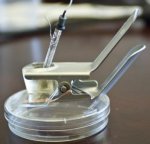Self assembling and self-repairing solar cells – there’s something very Terminator about it.
While solar panels are very long lasting and most manufacturers now provide a 25 year power output warranty, the cells do degrade over time due to constant bombardment by the sun. A traditional solar panel may function for decades, but with each passing year its efficiency in converting sunlight to electricity slightly lessens.
Conventional silicon-based photovoltaic cells suffer little degradation, but significant degradation can be experienced by thin film based solar products.
Plants are exposed to the same sort of harsh conditions, but being living creatures; they are able to repair any damage done. Plants continually deconstruct their damaged light capturing molecules and rebuild them.
Massachusetts Institute of Technology scientists have succeeded in replicating a key aspect of that process, a first step towards the creation of self-repairing and self-assembling solar cells.
Charles and Hilda Roddey Associate Professor of Chemical Engineering Michael Strano and his team have produced synthetic molecules called phospholipids that form discs and provide structural support for other light-responsive molecules in structures called reaction centers, which release electrons when struck by particles of light.
The discs are in a solution where they attach themselves spontaneously to carbon nanotubes – hollow tubes of carbon atoms capable of conducting electricity a thousand times better than copper. The nanotubes act as wires to collect and route the flow of electrons knocked loose by the reactive molecules.
When a surfactant is added to the mix, the components disintegrate and form a soupy solution. When the surfactant is removed by forcing the solution through a membrane, the compounds spontaneously reformed into a rejuvenated photocell, with no loss of efficiency.
The efficiency of these molecular structures in converting sunlight is an impressive 40 percent and could theoretically be brought to close to 100 percent. However, the concentration of the structures in the solution is low and the team are now working towards finding ways to greatly increase the concentration.












































